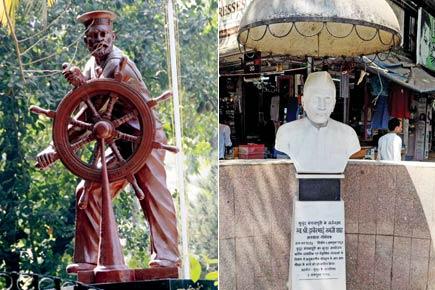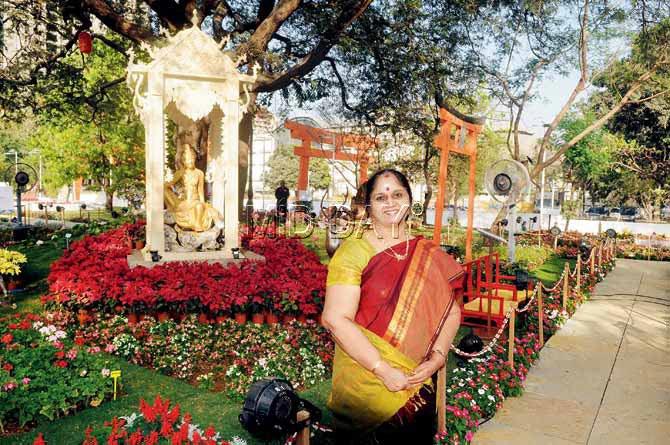Once a former Mauryan empire outpost, little known Mulund presents Bombay's best planned suburb

.
 Mulund old-timer Girija Chandramouli in the Buddhist garden at the Royal Revanta flower show. Emperor Ashoka was among the first to step foot in this suburb, then a part of Thana. Pics/Datta Kumbhar
Mulund old-timer Girija Chandramouli in the Buddhist garden at the Royal Revanta flower show. Emperor Ashoka was among the first to step foot in this suburb, then a part of Thana. Pics/Datta Kumbhar
ADVERTISEMENT
Music and Mulund are my life," chirps Carnatic singer Seetha Jayaraman. "No, Mulund and music are my life!" the principal of the Mulund Music and Dance School corrects herself. Affable, voluble and unstoppable as she speaks of the north-east suburb that is her long-time home, Jayaraman is hardly alone. Most Mulund residents seem inordinately proud of their turf. For reasons ranging from "Because this is where you have the kindest neighbours and friends" to "There isn't a greener, safer spot in this city".
 Crisscrossing neat, tree-lined roads reveals the Prince of Suburbs, as it is hailed, to wear an air of restful ease extending even to what should be Saturday morning bustle and boom. The serenity dates back to Emperor Ashoka's reign, when Buddhist monks rested here, as they did near ports later assigned names of gods and goddesses. The ancient area derived from Mahabali to Muchalind to Mul-Kund. A 10th-century Tamrapatra copper plate discovered from the Shilahara era bears further evidence, inscribed with the word 'Mulund'. Mulund had another unusual moniker. Mangalapuri. Eighty-six-year-old Ramnikbhai Shah explains how that came to be coined. Rising from an apprenticeship with a Masjid Bunder merchant, his Saurashtra-born father Jhaverbhai emerged a visionary zamindar who owned Jhaverbhai Narottamdas & Company and land acres stretching till Agra Road. In 1922, he gave the architectural firm of Crown & Carter freedom to design Mulund in Gridiron Plan — streets running at right angles to each other from the station to Paanch Rasta junction. Tagging together the names of his daughter Mangala and wife Puri, the result was one of Bombay's finest: Mangalapuri Town Planning Scheme.
Crisscrossing neat, tree-lined roads reveals the Prince of Suburbs, as it is hailed, to wear an air of restful ease extending even to what should be Saturday morning bustle and boom. The serenity dates back to Emperor Ashoka's reign, when Buddhist monks rested here, as they did near ports later assigned names of gods and goddesses. The ancient area derived from Mahabali to Muchalind to Mul-Kund. A 10th-century Tamrapatra copper plate discovered from the Shilahara era bears further evidence, inscribed with the word 'Mulund'. Mulund had another unusual moniker. Mangalapuri. Eighty-six-year-old Ramnikbhai Shah explains how that came to be coined. Rising from an apprenticeship with a Masjid Bunder merchant, his Saurashtra-born father Jhaverbhai emerged a visionary zamindar who owned Jhaverbhai Narottamdas & Company and land acres stretching till Agra Road. In 1922, he gave the architectural firm of Crown & Carter freedom to design Mulund in Gridiron Plan — streets running at right angles to each other from the station to Paanch Rasta junction. Tagging together the names of his daughter Mangala and wife Puri, the result was one of Bombay's finest: Mangalapuri Town Planning Scheme.
.jpg) The sailors’ monument at Cooperage commemorating bravehearts of the 1946 naval uprising against the British, sculpted by Neelkanth Khandvilkar. At least 500 prisoners of that struggle were interned in a camp at Mulund
The sailors’ monument at Cooperage commemorating bravehearts of the 1946 naval uprising against the British, sculpted by Neelkanth Khandvilkar. At least 500 prisoners of that struggle were interned in a camp at Mulund
"In 1940-41, my classmates and I used to dash out for a unique short break snack," Shah says. "We simply reached out to pluck bor from forests around." There grew an equal abundance of jambul, jackfruit, mango and cashew trees. "We were a small village with phones in three homes. A couple of families had cars, two Fords borrowed by anyone needing them on certain days."
Transport graduated from handcarts to public buses that trundled down leafy Mulund lanes thanks to enterprising Sindhi immigrants, rickety vehicles that provided services preceding BEST routes. Post-Partition, a wave of 2,00,000 refugees from across the border found accommodation in relief camps and colonies in Mulund and Chembur. I pick up such local history nuggets from a grand old man of Mulund. My friend Girija Chandramouli obligingly tracks the streets of her childhood, taking me to KS Rajagopalan. At 90, he beams benignly at his protégé — he was first boss and mentor to Girija, now deputy financial adviser and chief accounts officer of Central Railways.
.jpg) "Old Mulund, all salt pans and wilderness, would make people exclaim 'Jungle hai, kaun jayega udhar?" says S Jayaraman, Seetha's husband. He still prefers catching films at 1976-built Mehul Talkies rather than in multiplexes here. Jawahar, the earliest single screen is shuttered, as is Deepmandir.Ramnik Shah at his home; (Inset) Statue of his father Jhaverbhai, the visionary landowner who gave the firm of Crown & Carter free rein to plan 1922 Mulund in Gridiron style, roads running right-angled to each other.
"Old Mulund, all salt pans and wilderness, would make people exclaim 'Jungle hai, kaun jayega udhar?" says S Jayaraman, Seetha's husband. He still prefers catching films at 1976-built Mehul Talkies rather than in multiplexes here. Jawahar, the earliest single screen is shuttered, as is Deepmandir.Ramnik Shah at his home; (Inset) Statue of his father Jhaverbhai, the visionary landowner who gave the firm of Crown & Carter free rein to plan 1922 Mulund in Gridiron style, roads running right-angled to each other.
"Our kuchcha paths were rollercoasters!" Rajagopalan laughs. "We've gone from little huts to big towers, yet remain cosmopolitan as ever." A string of temples, gurdwaras, churches and shrines form a remarkably convivial communal cauldron. Gujaratis, Maharashtrians, Malayalis, Tamilians, Kannadigas, Sikhs, Christians, Sindhis and Punjabis enjoy uncommon peace in Mulund. Jaswinder Singh, an engineering goods manufacturer in Model Town colony since 1980, tells me there's no location to beat his nestled in the Yeoor hills. Girija observes, "Tamilians and Gujaratis often live in proximity." Before I can proffer that this could be their vegetarian food bond, Rajagopalan adds: "We mix well, respecting each other's customs and language especially." Looking to rent the ground floor flat where we sit (typical of two-three storey blocks that mushroomed in Mulund from the 1950s), Rajagopalan's wife won over the Kutchi landlord the instant she spoke in fluent Gujarati.
Such a socio-cultural swirl might trail to the tolerance imbibed from serial dynastic sweeps Mulund has witnessed. Nothing could highlight those valiant histories more fetchingly than a recent garden show, 'Revanta Royal Festival: The Spirit of Mul-Kund'. An antique bronze sculpture, the Revanta horse was depicted as a protector of the pastoral world. Presented by Piramal Realty, the display paid tribute to successive rulers in Mulund, a pavilion for each, bursting with orchids, lilies, dahlias, petunias and zinias. Relics and remnants suggesting the 3rd century BC coming of the Magadha kings lay strewn in The Mauryan Garden. Prathestha Mir, Chandragupta Maurya's governor, integrated Mulund, once a part of Thana, into the broader principality of Vidharbha.
The next exhibit, a horse fashioned from twigs, represented the Satavahanas, master horsemen who ruled Thana-Mulund inhabited by Agri farmers. The Old Bombay Garden celebrated references to Thana by Greek geographer Ptolemy (he christened tracts around its creek Chersonesus), as well as travellers Ibn Battuta (whose name for Thane was Kukin Tana, the port from which ships sailed to the Gulf carrying cloths called Tanasi) and Duarte Barbosa pronouncing it Tana Mayambi 25 years before the Portuguese conquest.
.jpg)
The Mughal advance was acknowledged with a fragrant Rickshaw of Roses, the 300-year Maratha regime with a strong Deccani horse representing Shivaji's nimble army steeds. Gorgeous Paithani silk sarees draped around bullock carts amid beds of flaming marigolds completed the Peshwa picture.
"We conceived this mindful of Harvard anthropologist EO Wilson's theory of biophilia," says Dr Swati Piramal. "That is the innate, genetic affinity of humans with nature. Builders promise green spaces but uproot them for parking lots. People need unstructured open expanses children can play in. They have neither air nor light to sprout a Tulsi plant in matchbox apartments. Future generations will live in harmony with the environment only through sustainable architecture and sensitive development."
The suburb today attracts families settling within quick access of malls, hospitals and schools beyond legendary institutions like Sheth Motibai Pachan Rashtriya Shala, Sheth Karamshi Kanji English School and Vani Vidyalaya. Mulund is also a vital industrial centre with foundries, chemical factories and pharmaceutical hubs. Though Lal Bahadur Shastri Marg is a main artery, inner gullies hold the oldest shops and eateries. Walking into Madras Stores on MG Road, stocked with seasonings, condiments and handlooms, Girija and I sniff an appetising swathe of scents – mango pickle, lemon rice masala, sambar packets, coffee powder and mouth-watering chivda flavours. Proprietor Subramanian P recalls his father Parameshwaran opened the shop 70 years ago as a dairy products outlet. Few realise Mulund was associated with the insurrection which the British dubbed the Naval Mutiny, a year before Independence. While national figures like Gandhiji and Vallabhbhai Patel advised restraint, Bombay leaders Aruna Asaf Ali and Achyut Patwardhan supported the brave signallers, stokers and sweepers. About 500-600 arrested were interned in Mulund prison camps, among them MS Khan and Madan Singh, president and vice-president of the Naval Central Strike Committee. Chanting 'Not mutiny but unity', they went on hunger strike before being released and dismissed from service. (Incidentally, then navy head, Admiral John H Godfrey, had as an assistant Ian Fleming, who went on to memorably base the character of 'M' in Bond books on Godfrey.)
Another compelling literary allusion to the event appears in Rushdie's picaresque novel The Moor's Last Sigh. Moraes Zogoiby describes his mother Aurora painting the protesters. 'In February 1946, when Bombay, that super epic motion picture of a city, transformed overnight into a motionless tableau by great naval and landlubber strikes, when ships did not sail, steel was not milled, textile mills neither warped nor woofed... she set about capturing history in charcoal.'
Capturing history in flowers much the same way, those pretty blooms swaying in a cool March dusk at the Revanta history-through-horticulture show traced Mulund's dynamic DNA. I dwell some more on the Islamic white garden for Mohammed Bin Tughlaq, on a 130-year-old stepped wooden altar as a metaphor for the Portuguese presence, on a garlanded teapot to mark the marriage of Catherine of Portugal-Charles II of England transferring Bombay to the Crown.
Finally, an installation of white sheep in a wheat grass meadow. Baroda artist Arunanshu Chaudhary positioned a solitary black sheep beside them, standing tall, happily different. That topiary corner conveyed diversity and inclusion — an apt message from Mulund to Mumbai.
 Subscribe today by clicking the link and stay updated with the latest news!" Click here!
Subscribe today by clicking the link and stay updated with the latest news!" Click here!







